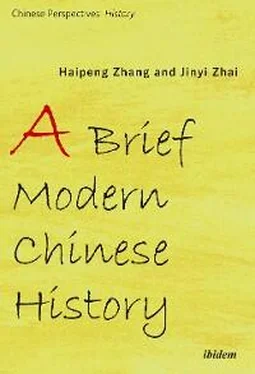China was at war. Li Hongzhang had to abandon his pursuit of peace and instead turned to passive defense. He did not follow the Emperor Guangxu’s suggestion that the imperial court should send reinforcements to join Qing’s army in Korea and combine forces to attack Seoul, but instead ordered the Qing troops to defend Pyongyang and fight steadfastly. Li gave priority to protecting the warships rather than attacking the enemy. Li dreamed that his battleships anchored in the Bohai Gulf would prove to be the fiercest fighting ships. However, this involved giving up the command of the Yellow Sea, which would mean Japan could safely transport troops over water.
The land battle was fought in Pyongyang. The Qing army stationed there had 15,000 soldiers, 28 mountain guns, 4 field guns, and 6 machine cannons. The Japanese army had over 17,000 men in possession of 44 mountain artilleries. The Japanese vehemently attacked Pyongyang, resulting in a general from Qing’s army dying in battle and Qing army’s commander fleeing once again. Pyongyang fell into the hands of the enemy.
The Yellow Sea Battle then took place. Japan spent much time planning this battle. For this reason, the Japanese fleet was superior to China’s Northern Fleet (see table below). 48
|
Chinese Fleet |
Japanese Fleet |
| Number of warships |
10 |
12 |
| Total tonnage |
31,366 |
40,849 |
| Total strength |
2,000 |
3,500 |
| Average speed (nmi) |
15.5 |
16.5 |
| Number of artilleries |
173 |
171 |
| Number of quick-firing guns |
0 |
97 |
The Northern Fleet’s performance was clumsy in the face of the Japanese navy’s surprise attack 49and it suffered heavy losses. The Northern Fleet lost five battleships and a number of excellent naval officers. Fortunately, most of the capital ships were saved. The Chinese navy inflicted heavy losses on the Japanese, including five battleships being severely damaged and more than 300 soldiers and officers killed or injured. The Northern Fleet lost for a number of reasons. First, Li Hongzhang’s operational plan was too passive. Second, Qing’s navy lagged far behind Japan’s in terms of modernization. The Qing navy desperately lacked money, the leadership was inconsistent, and the navy itself was poorly commanded and poorly trained. The Zhiyuan 致 远, the fastest battleship of the Northern Fleet, vigorously pursued and fiercely mauled the Yoshino 吉野, one of the largest Japanese warships. When realizing that it had run out of ammunition, the Zhiyuan decided to ram the Yoshino ; however, it was sunk by the enemy.
Frightened by the Yellow Sea Battle, Li Hongzhang prohibited Chinese warships from going to sea, arguing that the Northern Fleet should only be used for defense. Japan had naval supremacy and consequently began landing their army in China, an operation which took place over nine days. The Northern Fleet took no action when the Japanese army attacked bases in Lüshun and captured Jinzhou and Dalian. Li Hongzhang had spent tens of millions of taels of silver building the naval port of Lüshun, which was nicknamed the Iron Garrison. It was stocked with a huge number of powerful, advanced Western weapons and this was the reason why the Japanese troops did not risk a frontal attack. After taking Jinzhou and Dalian, the Japanese decided to launch an assault on Lüshun. Li resolved to defend Lüshun at all costs, 50and sent reinforcements of 20,000 men. At this time, Qing’s army turned and marched toward Jinzhou; however, the Japanese troops were caught in the crossfire between the two Qing armies. In 1894, Lüshun fell. The Japanese army massacred 20,000 civilians, 51which caused outrage throughout the world and condemnation of Japan. Mutsu Munemitsu 陆奥宗光, Japan’s foreign minister, later recalled that after this massacre, Japan was seen as no more than a brutal and cruel monster. 52
On the same day the Japanese army landed at Huayuankou, some Japanese troops led by their commander-in-chief crossed the Yalu River and attacked the Chinese garrisons. The Japanese army had slightly more than 10,000 soldiers in contrast to Qing’s defending army of 70 camps and 20,000 soldiers in total. It took the Japanese merely two days to break Qing’s defense. On the first day of December, 1894, the Japanese army occupied the strategic city of Haicheng. Qing’s army of 60,000 men then attacked this city. The battle lasted until February, 1895, when Japan’s reinforcements arrived and helped to secure the city.
Japan’s next target was Weihai, another key naval port belonging to Qing. 20,000 Japanese soldiers arrived in Weihai, which was protected by eight batteries with more than one hundred powerful Western cannons. Weihai was the headquarters of Qing’s navy. After the Yellow Sea Battle, the rest of the Northern Fleet, which included seven battleships, six gunboats, 13 torpedo boats and two training vessels, lay at anchor in Weihai. Li Hongzhang did not allow any ships to leave this naval port, hoping that his fleet would avoid more losses. However, he repeated the same mistake as in Lüshun.
After several days, the Japanese destroyed the batteries and killed more than 1,000 defenders. The Japanese army then blocked all exit points and turned all the Chinese warships into sitting ducks. In spite of resisting fiercely, the entire Northern Army fleet was wiped out. Some foreign employees and Qing’s naval officers orchestrated a mutiny, forcing Ding Ruchang, the highest commander in the Qing navy, to surrender to the Japanese. Ding ordered them to desist; however, they would not listen. Finally, Ding and other senior officers chose to commit suicide rather than surrender. Japan seized the remaining Chinese warships and a large quantity of equipment in the naval base. The Northern Fleet, the symbol of China’s three-decade SSM, was erased from history. Disappointed at Li’s military inability, Qing’s imperial court placed its hopes in the Hunan Army, which played a pivotal role in putting down the Taiping Rebellion. However, the Hunan Army did not have success. The leader, the Governor General of both Jiangnan and Jiangxi, was not able to respond properly. The Japanese troops soon captured western Liaoning and the advancing army posed a great threat to Beijing.
Emperor Guangxu made concessions for peace; the conservatives, such as Cixi, did too. However, after Japan’s capture of Lüshun, the West started to worry that Japan could harm its own interests. Britain warned Japan that if they attacked Beijing and Qing collapsed, Japan would gain nothing. The United States warned Japan that if the war was continued, they would try to end it at the expense of Japan’s stability and prosperity. At this stage, Japan’s troops were almost exhausted. Ito Hirobumi, who was then heading the Japanese government, concluded that toppling Qing would lead to the Western powers’ intervention. Japan forced Qing to sign a peace treaty, which was to its own benefit. Japan however, refused to receive the Chinese delegation headed by several senior ministers, and said that only Li Hongzhang or Yixin (the leading prince) was qualified to negotiate. Thus, Li was sent to Japan.
The Treaty of Shimonoseki and the Cession of Taiwan
As part of the negotiations, Japan demanded that China cede several pieces of territory to Japan. China should also recognize Korea’s dependence on Japan and pay war reparations. Li Hongzhang was given the right to decide whether to agree to these terms. 53The Emperor and high ministers discussed giving up land, though they did not agree. 54They sent word to Qing’s de facto paramount leader, Cixi; however, they received no reply. Li was left to decide by himself. 55In March, 1895, the Chinese and Japanese delegates met in Shimonoseki. The Japanese said that their conditions included, 1) Japan’s occupation of Dagu, Tianjin, and Shanhaiguan; 2) Japan’s management of the railroad connecting Tianjin and Shanhaiguan; and 3) China’s commitment to pay all war expenses during the truce. Li argued that the Japanese were too greedy and decided not to go through with the negotiations. Unexpectedly, a ronin (i.e., an impoverished Japanese samurai) attempted to assassinate Li, which resulted in him being seriously wounded. The global media was in an uproar. Worrying about foreign powers intervening, the Japanese government approved a 21-day truce. However, the truce was not applicable to Taiwan and Penghu 澎 湖. In the beginning of April, Japan told Li, who was still injured, that peace was based on the fulfillment of China’s recognition of Japan’s full control of Korea; the cession of Taiwan, Penghu, and Liaodong Peninsula to Japan; and China’s payment of reparations of 200,000,000 taels of silver to Japan. Li wrote a long letter, attempting to persuade Japan to change its demands. However, he was unsuccessful and the Japanese repeatedly threatened to attack Beijing. On April 10, Japan issued an ultimatum to Li, demanding an answer to its demands. Li sent a telegram to Emperor Guangxu, telling him that he could not do anything about the situation. Seven days later, Li signed the Treaty of Shimonoseki giving Japan what it desired, land, money, 56and various privileges in China.
Читать дальше












